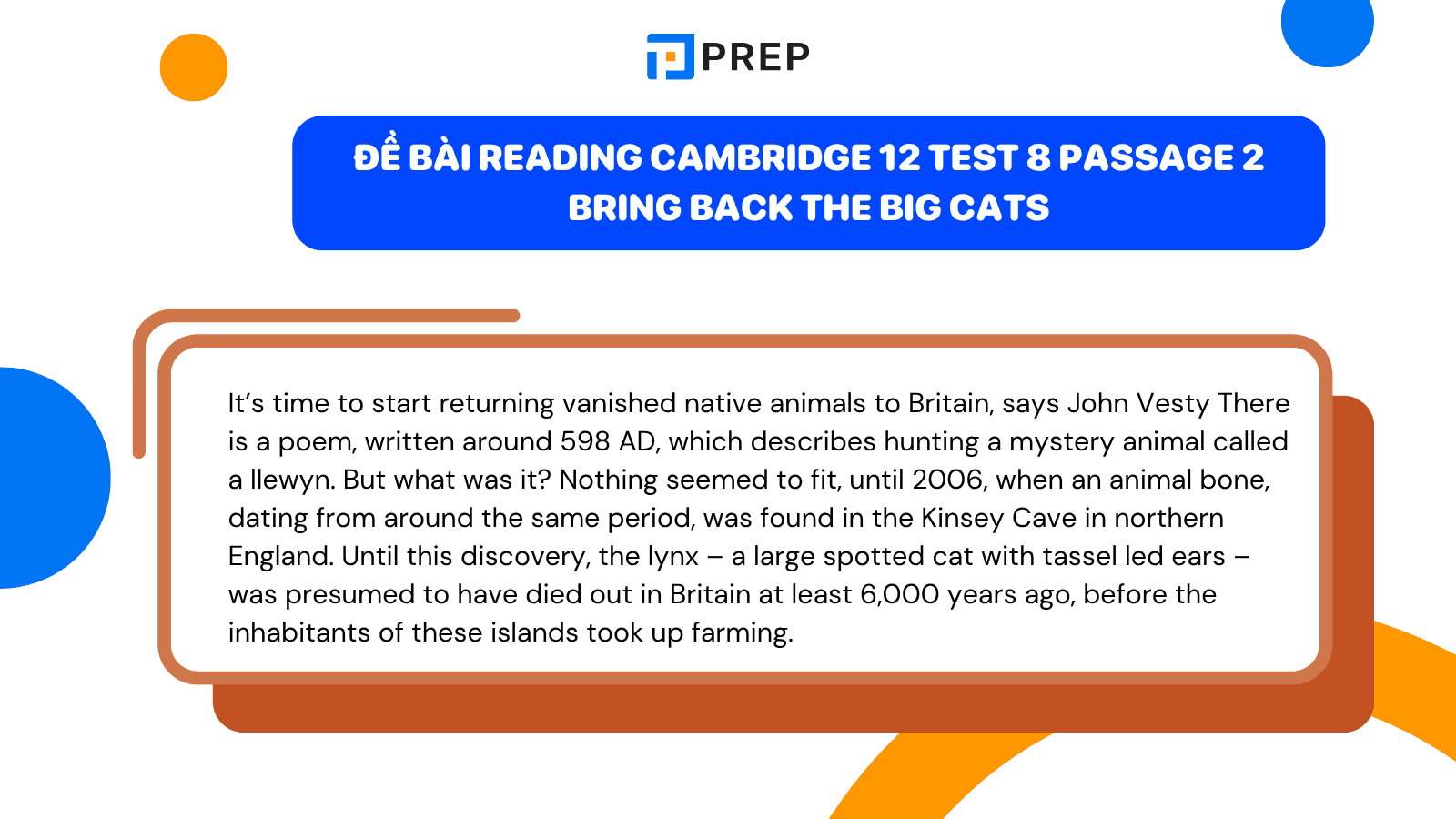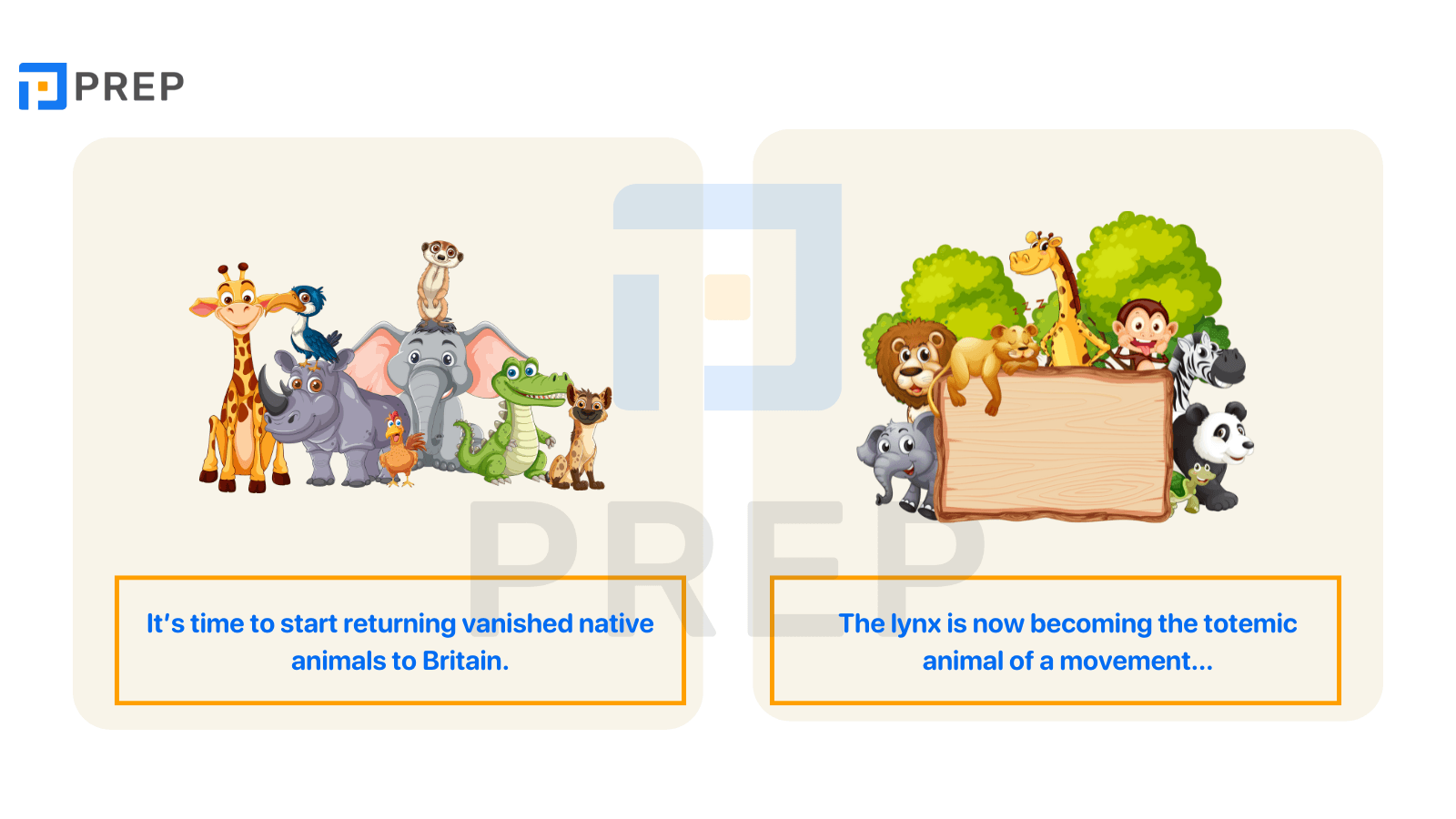Đề bài và đáp án chi tiết reading Cambridge 12 test 8 passage 2 Bring Back The Big Cats
Bài đọc IELTS Cambridge 12 Test 8 Passage 2 “Bring Back the Big Cats” là một bài viết học thuật về chủ đề tái du nhập các loài thú săn mồi lớn như sư tử và báo vào môi trường tự nhiên ở Anh. Dạng bài này thường xuất hiện trong phần IELTS Reading Passage 2, thí sinh cần phân tích lập luận khoa học, bằng chứng, và quan điểm cá nhân của tác giả. Trong bài viết dưới đây, Prep sẽ cung cấp đề bài, đáp án chi tiết, phần giải thích từng câu hỏi và bảng từ vựng hay trong bài, giúp bạn hiểu sâu hơn về chiến lược làm dạng đọc học thuật và nâng cao kỹ năng phân tích ý chính trong bài đọc IELTS.

I. Đề bài reading Cambridge 12 test 8 passage 2 Bring Back The Big Cats
Đọc đề bài reading Cambridge 12 test 8 passage 2 Bring Back The Big Cats:
It’s time to start returning vanished native animals to Britain, says John Vesty There is a poem, written around 598 AD, which describes hunting a mystery animal called a llewyn. But what was it? Nothing seemed to fit, until 2006, when an animal bone, dating from around the same period, was found in the Kinsey Cave in northern England. Until this discovery, the lynx – a large spotted cat with tassel led ears – was presumed to have died out in Britain at least 6,000 years ago, before the inhabitants of these islands took up farming. But the 2006 find, together with three others in Yorkshire and Scotland, is compelling evidence that the lynx and the mysterious llewyn were in fact one and the same animal. If this is so, it would bring forward the tassel-eared cat’s estimated extinction date by roughly 5,000 years.
However, this is not quite the last glimpse of the animal in British culture. A 9th- century stone cross from the Isle of Eigg shows, alongside the deer, boar and aurochs pursued by a mounted hunter, a speckled cat with tasselled ears. Were it not for the animal’s backside having worn away with time, we could have been certain, as the lynx’s stubby tail is unmistakable. But even without this key feature, it’s hard to see what else the creature could have been. The lynx is now becoming the totemic animal of a movement that is transforming British environmentalism: rewilding.
Rewilding means the mass restoration of damaged ecosystems. It involves letting trees return to places that have been denuded, allowing parts of the seabed to recover from trawling and dredging, permitting rivers to flow freely again. Above all, it means bringing back missing species. One of the most striking findings of modern ecology is that ecosystems without large predators behave in completely different ways from those that retain them. Some of them drive dynamic processes that resonate through the whole food chain, creating niches for hundreds of species that might otherwise struggle to survive. The killers turn out to be bringers of life.
Such findings present a big challenge to British conservation, which has often selected arbitrary assemblages of plants and animals and sought, at great effort and expense, to prevent them from changing. It has tried to preserve the living world as if it were a jar of pickles, letting nothing in and nothing out, keeping nature in a state of arrested development. But ecosystems are not merely collections of species; they are also the dynamic and ever-shifting relationships between them. And this dynamism often depends on large predators.
At sea the potential is even greater: by protecting large areas from commercial fishing, we could once more see what 18th-century literature describes: vast shoals of fish being chased by fin and sperm whales, within sight of the English shore. This policy would also greatly boost catches in the surrounding seas; the fishing industry’s insistence on scouring every inch of seabed, leaving no breeding reserves, could not be more damaging to its own interests.
Rewilding is a rare example of an environmental movement in which campaigners articulate what they are for rather than only what they are against. One of the reasons why the enthusiasm for rewilding is spreading so quickly in Britain is that it helps to create a more inspiring vision than the green movement’s usual promise of ‘Follow us and the world will be slightly less awful than it would otherwise have been.
The lynx presents no threat to human beings: there is no known instance of one preying on people. It is a specialist predator of roe deer, a species that has exploded in Britain in recent decades, holding back, by intensive browsing, attempts to re-establish forests. It will also winkle out sika deer: an exotic species that is almost impossible for human beings to control, as it hides in impenetrable plantations of young trees. The attempt to reintroduce this predator marries well with the aim of bringing forests back to parts of our bare and barren uplands. The lynx requires deep cover, and as such presents little risk to sheep and other livestock, which are supposed, as a condition of farm subsidies, to be kept out of the woods.
On a recent trip to the Cairngorm Mountains, I heard several conservationists suggest that the lynx could be reintroduced there within 20 years. If trees return to the bare hills elsewhere in Britain, the big cats could soon follow. There is nothing extraordinary about these proposals, seen from the perspective of anywhere else in Europe. The lynx has now been reintroduced to the Jura Mountains, the Alps, the Vosges in eastern France and the Harz mountains in Germany, and has re-established itself in many more places. The European population has tripled since 1970 to roughly 10,000. As with wolves, bears, beavers, boar, bison, moose and many other species, the lynx has been able to spread as farming has,left the hills and people discover that it is more lucrative to protect charismatic wildlife than to hunt it, as tourists will pay for the chance to see it. Large-scale rewilding is happening almost everywhere – except Britain.
Here, attitudes are just beginning to change. Conservationists are starting to accept that the old preservation-jar model is failing, even on its own terms. Already, projects such as Trees for Life in the Highlands provide a hint of what might be coming. An organisation is being set up that will seek to catalyse the rewilding of land and sea across Britain, its aim being to reintroduce that rarest of species to British ecosystems: hope.
Questions 1-5
Write the correct letter, A, B, C or D, in boxes 1-5 on your answer sheet.
1 What did the 2006 discovery of the animal bone reveal about the lynx?
Check answers
-
A Its physical appearance was very distinctive.
-
B Its extinction was linked to the spread of farming.
-
C It vanished from Britain several thousand years ago.
-
D It survived in Britain longer than was previously thought.
2 What point does the writer make about large predators in the third paragraph?
Check answers
-
A Their presence can increase biodiversity.
-
B They may cause damage to local ecosystems.
-
C Their behaviour can alter according to the environment.
-
D They should be reintroduced only to areas where they were native.
3 What does the writer suggest about British conservation in the fourth paragraph?
Check answers
-
A It has failed to achieve its aims.
-
B It is beginning to change direction.
-
C it has taken a misguided approach.
-
D It has focused on the most widespread species.
4 Protecting large areas of the sea from commercial fishing would result in
Check answers
-
A practical benefits for the fishing industry.
-
B some short-term losses to the fishing industry.
-
C widespread opposition from the fishing industry.
-
D certain changes to techniques within the fishing industry.
5 According to the author, what distinguishes rewilding from other environmental campaigns?
Check answers
-
A Its objective is more achievable.
-
B Its supporters are more articulate.
-
C Its positive message is more appealing.
-
D It is based on sounder scientific principles.
Questions 6-9
Complete the summary using the list of words and phrases A-F below.
Write the correct letter, A-F, in boxes 6-9 on your answer sheet.
Reintroducing the lynx to Britain
Check answers
There would be many advantages to reintroducing the lynx to Britain. While there is no evidence that the lynx has ever put 6 in danger, it would reduce the numbers of certain 7 whose populations have increased enormously in recent decades. It would present only a minimal threat to 8 , provided these were kept away from lynx habitats. Furthermore, the reintroduction programme would also link efficiently with initiatives to return native 9 to certain areas of the country.
|
A |
trees |
B |
endangered species |
C |
hillsides |
|
D |
wild animals |
E |
humans |
F |
farm animals |
Questions 10-13
Do the following statements agree with the claims of the writer in Reading Passage?
In boxes 10-13 on your answer sheet, write
YES if the statement agrees with the claims of the writer
NO if the statement contradicts the claims of the writer
NOT GIVEN if it is impossible to say what the writer thinks about this
Check answers
Choose an optionYESNONOT GIVEN10 Britain could become the first European country to reintroduce the lynx.
Choose an optionYESNONOT GIVEN11 The large growth in the European lynx population since 1970 has exceeded conservationists’ expectations.
Choose an optionYESNONOT GIVEN12 Changes in agricultural practices have extended the habitat of the lynx in Europe.
Choose an optionYESNONOT GIVEN13 It has become apparent that species reintroduction has commercial advantages.

II. Đáp án reading Cambridge 12 test 8 passage 2 Bring Back The Big Cats
Đáp án reading Cambridge 12 test 8 passage 2 Bring Back The Big Cats:
|
1. D |
8. F |
|
2. A |
9. A |
|
3. C |
10. NO |
|
4. A |
11. NOT GIVEN |
|
5. C |
12. YES |
|
6. E |
13. YES |
|
7. D |
|
III. Giải thích đáp án chi tiết – Cambridge 12 Test 8 Passage 2: “Bring Back the Big Cats”
|
Câu hỏi |
Đáp án |
Giải thích chi tiết |
|
1. D |
It survived in Britain longer than was previously thought. |
Bài nói rằng phát hiện xương linh miêu năm 2006 cho thấy loài này còn tồn tại ở Anh lâu hơn so với suy nghĩ trước đây (“the 2006 find ... brings forward the extinction date by roughly 5,000 years”). → Đáp án D đúng. |
|
2. A |
Their presence can increase biodiversity. |
Tác giả viết: “Ecosystems without large predators behave in completely different ways... creating niches for hundreds of species...” → Điều này chứng minh sự có mặt của loài săn mồi lớn giúp tăng đa dạng sinh học, nên A là chính xác. |
|
3. C |
It has taken a misguided approach. |
Trong đoạn 4, tác giả chỉ trích bảo tồn ở Anh “as if it were a jar of pickles... keeping nature in a state of arrested development.” → Nghĩa là phương pháp bảo tồn ở Anh là sai lầm, cố giữ tự nhiên trong trạng thái tĩnh. |
|
4. A |
Practical benefits for the fishing industry. |
Đoạn 5: bảo vệ vùng biển khỏi khai thác thương mại “would greatly boost catches in the surrounding seas.” → Lợi ích thực tế cho ngành đánh cá, chọn A. |
|
5. C |
Its positive message is more appealing. |
Đoạn 6: Rewilding khác biệt vì “it helps to create a more inspiring vision than the usual promise of ‘the world will be slightly less awful’.” → Thông điệp tích cực và hấp dẫn hơn, nên C đúng. |
|
6. E |
humans |
Đoạn 7: “The lynx presents no threat to human beings.” → Không có bằng chứng rằng linh miêu tấn công người, chọn E. |
|
7. D |
wild animals |
Bài viết nói lynx săn roe deer và sika deer, đều là động vật hoang dã, chọn D. |
|
8. F |
farm animals |
“...little risk to sheep and livestock... kept out of the woods.” → Mối nguy rất nhỏ với gia súc, chọn F. |
|
9. A |
trees |
“The attempt to reintroduce this predator marries well with the aim of bringing forests back...” → Gắn liền với việc phục hồi rừng cây, nên chọn A. |
|
10. NO |
Đoạn 8 nói: “The lynx has been reintroduced to... France, Germany...” → Các nước khác đã làm trước, nên Anh không phải đầu tiên, chọn NO. |
|
|
11. NOT GIVEN |
Không có thông tin nào nói số lượng linh miêu tăng vượt ngoài mong đợi, chỉ nói “tripled since 1970”, nên NOT GIVEN. |
|
|
12. YES |
“As farming has left the hills... lynx has been able to spread.” → Thay đổi trong nông nghiệp giúp mở rộng môi trường sống của linh miêu, nên YES. |
|
|
13. YES |
“...people discover it is more lucrative to protect wildlife than to hunt it.” → Tác giả khẳng định việc tái du nhập có lợi ích kinh tế, chọn YES. |
Xem thêm: Đề bài và đáp án chi tiết IELTS Cambridge 12 test 8 passage 1 The history of glass
IV. Từ vựng hay cần ghi nhớ
Take note nhanh một số từ vựng hay trong bài để mở rộng vốn từ nhé!
|
Từ vựng |
Nghĩa tiếng Việt |
Ví dụ |
|
vanished native animals |
các loài động vật bản địa đã biến mất (“vanished” = biến mất hoàn toàn; “native” = bản địa, thuộc nơi gốc sinh sống của loài đó) |
“It’s time to start returning vanished native animals to Britain.” → Đã đến lúc đưa các loài động vật bản địa đã biến mất trở lại nước Anh. |
|
lynx |
linh miêu (một loài mèo rừng cỡ trung bình, có tai tua dài và lông đốm đặc trưng) |
“The lynx is now becoming the totemic animal of a movement...” → Linh miêu giờ đây đang trở thành biểu tượng của một phong trào. |
|
rewilding |
tái hoang dã (phục hồi hệ sinh thái tự nhiên bằng cách đưa lại các loài đã tuyệt chủng cục bộ) |
“The rewilding movement is transforming British environmentalism.” → Phong trào tái hoang dã đang thay đổi tư duy bảo tồn ở Anh. |
|
denuded |
trơ trụi, bị tước mất lớp phủ thực vật |
“...letting trees return to places that have been denuded.” → Cho phép cây cối mọc lại ở những nơi đã bị trụi trơ. |
|
arbitrary assemblages |
sự kết hợp tùy tiện của các loài |
“British conservation has often selected arbitrary assemblages of plants and animals.” → Công tác bảo tồn ở Anh thường chọn những tập hợp loài tùy tiện để duy trì. |
|
arrested development |
sự phát triển bị kìm hãm |
“...keeping nature in a state of arrested development.” → Giữ thiên nhiên trong trạng thái bị ngăn phát triển. |
|
shoals of fish |
đàn cá lớn |
“...vast shoals of fish being chased by whales...” → Những đàn cá khổng lồ bị cá voi đuổi theo. |
|
charismatic wildlife |
động vật hoang dã có sức hút |
“...protect charismatic wildlife rather than hunt it.” → Bảo vệ các loài động vật hoang dã có sức hấp dẫn thay vì săn bắt chúng. |
|
lucrative |
sinh lợi, đem lại lợi ích kinh tế cao |
“...more lucrative to protect wildlife than to hunt it.” → Việc bảo tồn động vật hoang dã mang lại lợi nhuận cao hơn săn bắn. |
|
catalyse (v) |
xúc tác, thúc đẩy nhanh quá trình |
“An organisation will be set up to catalyse the rewilding of land and sea.” → Một tổ chức sẽ được thành lập để thúc đẩy quá trình tái hoang dã đất liền và biển. |
|
hope (as a metaphor) |
niềm hy vọng (ẩn dụ cho sự phục hồi môi trường) |
“...to reintroduce that rarest of species to British ecosystems: hope.” → Đưa trở lại hệ sinh thái Anh loài hiếm nhất: niềm hy vọng. |

Trên đây là đề bài và đáp án bài đọc reading IELTS Cambridge 12 test 8 passage 2 Bring Back The Big Cats. Hy vọng tài liệu trên sẽ hữu ích cho quá trình luyện thi IELTS của bạn.
Học tiếng Anh online dễ dàng hơn với PREP - Nền tảng Học & Luyện thi thông minh cùng AI. Nhờ công nghệ AI độc quyền, bạn có thể tự học trực tuyến ngay tại nhà, chinh phục lộ trình học IELTS, TOEIC, tiếng Anh giao tiếp hiệu quả. Bên cạnh đó, học viên còn có sự hỗ trợ tuyệt vời từ Teacher Bee AI, trợ lý ảo giúp bạn giải đáp thắc mắc và đồng hành 1-1 trong suốt quá trình học tập. Hãy click TẠI ĐÂY hoặc liên hệ HOTLINE 0931428899 để nhận tư vấn chi tiết về các khóa học tiếng Anh chất lượng nhất thị trường!
Tải ngay app PREP để bắt đầu hành trình học tiếng Anh tại nhà với chương trình học luyện thi online chất lượng cao.

Chào bạn! Mình là Hiền Hoàng, hiện đang đảm nhận vai trò quản trị nội dung sản phẩm tại Blog của website prepedu.com.
Với hơn 5 năm tự học các ngoại ngữ như tiếng Anh, tiếng Trung và ôn luyện một số kỳ thi IELTS, TOEIC, HSK, mình đã tự đúc rút được nhiều kinh nghiệm để hỗ trợ hàng nghìn người đang gặp khó khăn trong việc học ngoại ngữ. Hy vọng rằng những chia sẻ phía trên sẽ giúp ích cho bạn trong quá trình tự ôn luyện thi hiệu quả tại nhà!
Bình luận
Nội dung premium
Xem tất cảLộ trình cá nhân hoá
Có thể bạn quan tâm
Kết nối với Prep

MSDN: 0109817671.
Địa chỉ liên hệ: Tòa nhà Vinaconex, 34 Láng Hạ, phường Láng, TP Hà Nội.
Trung tâm CSKH tại HN: Lô 21 C2 Khu đô thị Nam Trung Yên, phường Yên Hòa, TP Hà Nội.
Trung tâm CSKH tại HCM: 288 Pasteur, Phường Xuân Hòa, TP Hồ Chí Minh
Trụ sở Công ty: Số nhà 20, ngách 234/35 đường Hoàng Quốc Việt, phường Nghĩa Đô, TP Hà Nội.
Phòng luyện ảo - Trải nghiệm thực tế - Công nghệ hàng đầu.
Hotline: 0931 42 8899.
Trụ sở Công ty: Số nhà 20, ngách 234/35 đường Hoàng Quốc Việt, phường Nghĩa Đô, TP Hà Nội.
Giấy chứng nhận hoạt động đào tạo, bồi dưỡng số 1309/QĐ-SGDĐT ngày 31 tháng 07 năm 2023 do Sở Giáo dục và Đào tạo Hà Nội cấp.

























